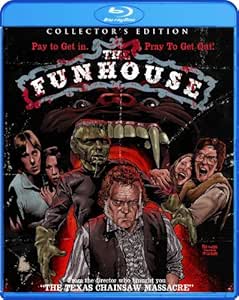Movie Review: The Funhouse (1981)
Tobe Hooper’s The Funhouse (1981) is a slow-burn carnival horror movie that trades jump scares for mood, dread, and one of the creepiest funhouse settings in genre history.
HORROR

★★★★★
I expected cheap thrills, but The Funhouse gave me something darker and more atmospheric.
Lacey M.
New Mexico
If your only memory of The Funhouse (1981) is its VHS cover sitting on the horror shelf in your local video store, you’re not alone. But trust me this is one of those films that sticks with you long after the credits roll, not because it’s packed with gore or jump scares (it’s not), but because it’s steeped in dread, with just enough freakish charm to leave a mark.
Directed by Tobe Hooper yes, that Tobe Hooper of The Texas Chain Saw Massacre fame The Funhouse is often overlooked in slasher conversations. It arrived during the genre’s boom era, but it feels like it’s playing a different game. Less body count, more atmosphere. Less teen hijinks, more existential discomfort. And all of it wrapped in carnival lights and mechanical laughs that never feel quite right.
At BoxReview.com, we’re always hunting down those horror flicks that slipped through the cracks and The Funhouse is one worth revisiting, especially if you're into slow-burn horror with heavy mood, bizarre characters, and a killer setting.
Setting the Scene: A Carnival From Your Nightmares
The premise is simple: four teenagers sneak into a traveling carnival’s funhouse for a night of mischief, only to discover they’ve witnessed a murder and now they’re trapped inside with a masked killer. It sounds familiar, but Hooper doesn’t rush into the action. Instead, he spends time building the world, and honestly, the carnival is the real star here.
From the opening scenes, there’s a lingering sense that something’s wrong even in broad daylight. Barkers leer, props malfunction, and every ride feels just a bit too offbeat. Hooper shoots the carnival like a rotting corpse dressed in neon. You can practically smell the stale popcorn and oil-soaked machinery. It’s one of the most textured horror settings of the ’80s.
And unlike many horror films of the era, The Funhouse treats its environment not as a backdrop, but as a living, breathing character. The maze-like structure of the ride, the sounds of laughter echoing through empty corridors, the dead-eyed mannequins it all creates a feeling that you’re stuck in a place that was never meant to be escaped.
Slasher Tropes With a Twist
Yes, the film has the standard ingredients: teens doing dumb things, a lurking killer, a final girl (Elizabeth Berridge as Amy, who’s better than she gets credit for). But Hooper plays with the formula in clever ways.
The pacing is deliberately slow in the first half, which might throw off viewers expecting instant carnage. But that’s the point. Hooper wants you to sit in the unease. He knows that real horror doesn’t come from a knife in the dark it comes from waiting for the knife.
And when the violence does hit, it’s surprisingly brutal and intimate. The deaths aren’t over-the-top; they feel claustrophobic, clumsy, and more realistic than you'd expect from a movie that features a mutant wearing a Frankenstein mask.
The Monster Behind the Mask: A Tragic Villain
Most reviews focus on the mutant killer as a generic horror monster, but there’s something sad and weirdly sympathetic about him. Known only as “Gunther,” he’s a deformed, childlike figure, kept hidden by his abusive father (played chillingly by Kevin Conway, who also portrays the carnival barker in multiple disguises).
Gunther isn’t a calculating slasher like Michael Myers or Jason. He’s more like Frankenstein’s monster confused, reactive, and used as a pawn. There’s something heartbreaking in his garbled cries and twitchy movements. He’s as much a victim of the funhouse as the teens are.
This subtle layer of empathy beneath the horror is classic Hooper. You saw it with Leatherface now you see it here.
What Most Reviews Miss: The Childhood Horror Connection
One of the most fascinating things about The Funhouse is how it plays with the fears of childhood growing up into something much darker. The film opens with a fake-out homage to Halloween and Psycho a kid in a mask with a knife, spying on his sister in the shower. It’s playful, but it sets the tone: this is a movie about the boundary between juvenile thrill-seeking and real terror.
It’s also a story about the loss of innocence. The carnival is something we associate with childhood joy, but Hooper twists it into something sinister a place where the masks never come off, and the performers are trapped in roles they can’t escape. There’s a quiet sadness here, buried under the blood.
The Verdict From BoxReview.com
Here at BoxReview.com, we love when a horror movie does more than it promises. The Funhouse could have been a simple “teens in danger” film, but instead it offers atmosphere, mood, and surprising depth. It’s not for everyone the slow build and lack of jump scares might turn off fans of more modern horror pacing but for those who appreciate tension over body counts, it’s a rewarding watch.
It’s not Tobe Hooper’s most famous film, but it might be his most underrated. He takes a garish, grimy world and makes it feel real then dares you to spend the night inside.
Box Review
Stay connected and follow us on social media for the latest reviews, movie highlights, and behind-the-scenes content.
© 2025-2030. All rights reserved.
Privacy & Legal
Join Our Newsletter!
RSS Feed
Built with ❤️ by CupidName.com

